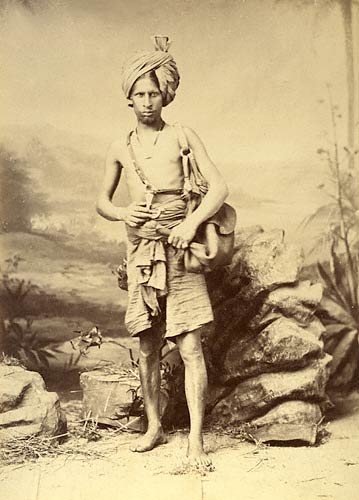“Drink water from your own cistern, running water from your own well. “
Proverbs 5:15 (NIV)
“Water is the driving force of all nature.”
Leonardo da Vinci
Global water issues: “1 in 3 people globally do not have access to safe drinking water. Every year, 297,000 children under 5 years die due to diarrhoea linked to inadequate water, sanitation and hygiene.”
WHO/UNICEF 2019
Discover the purpose of your work and your corporation
What is your purpose in work?
- Improving Public Health: Invest in clean water projects to combat diseases like cholera and dysentery caused by contaminated water sources.
- Reducing Plastic Pollution: Offer safe drinking water alternatives, reduce plastic bottled water consumption and promote environmental sustainability.
What drives your corporation’s core value?
- Affordable Access: Provide clean water at an affordable price, making it accessible to all.
- Benefits: Create social benefits for the local community and generate a stable income for the company.
A water-carrier in India, 1882.
1.0 Executive Summary
Mission
- Form strategic alliances with government agencies, foreign investors, and local water supply operators.
- Establish 14 new water treatment plants in major Borneo cities through a single PPP initiative.
Key Management Team
- Mentors: Visionary pioneers and industry leaders with a vast global network, providing invaluable guidance and inspiration.
- Coaches: Mission-oriented industry experts offering practical solutions to keep the team focused on its objectives.
- Partners:
- Project Leadership Group: Experienced in development, operational management, and global marketing within the WTP industry.
- Reputable Investment Manager: With access to funding sources in the Asia Pacific WTP industry.
- Government Agencies: Offering business and financial incentives to support our initiatives.
- Local Water Supply Developer: A credible partner with procurement capabilities, a strong local network, solid financial standing, and government support.
Product Benefits
- Health: Provides clean water for a healthier life.
- Green: Reduces plastic waste from bottles.
- Protection: Eliminates harmful microorganisms.
- Efficiency: Maintains appliance efficiency with soft water.
- Infrastructure: New WTP projects support government water supply goals and address leakage, groundwater depletion, and land subsidence.
Target Market
Kalimantan:
- New Capital
- Samarinda
- Banjarmasin
- Balikpapan
- Pontianak
- Palangkaraya
- Tarakan
- Tanjung Selor
Sabah:
- Kota Kinabalu
- Tawau
- Sandakan
Sarawak:
- Kuching
- Miri
Brunei:
- Bandar Seri Begawan
Financial Projections
Here are the financial projections for our project involving 14 Water Treatment Plants (WTPs) with a 35-year concession:
- Total Investment: US$19.8 billion
- Total Revenue: US$25.74 billion
- Total Income: US$5.94 billion
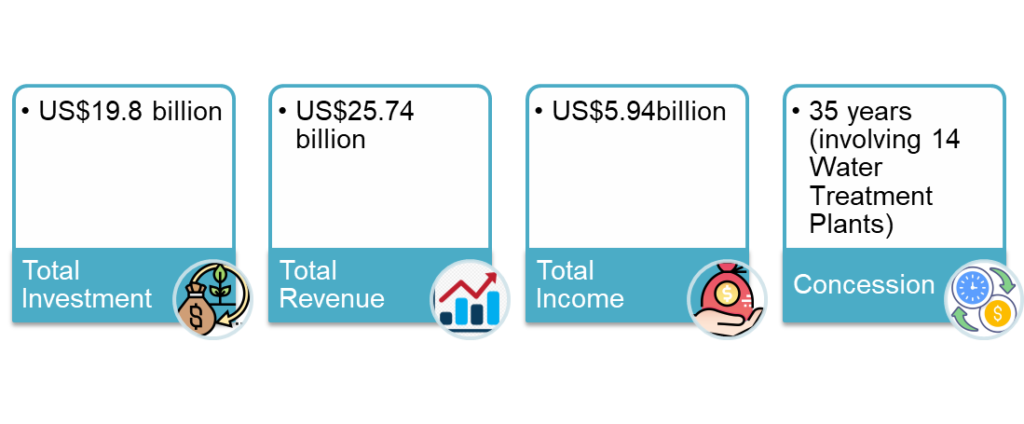
Additionally, on an annual basis:
- Water Tariff Cost: US$297 million/year
- Water Tariff Revenue: US$371.1 million/year
- Water Tariff Income: US$74.1 million/year

Unique Business Model
- Experienced Team: Led by water supply experts.
- Global Strength: Leveraging international expertise.
- Financial Backing: From foreign investors.
- Collaborative Partnerships: Uniting PPP stakeholders.
- Market Demand: Securing steady demand in target markets.
2.0 Mission
2.1 Problem
- Demand: Borneo faces rising demand, a drinking water shortage, and limited clean water access.
- Pollution: Agricultural runoff contaminates rivers, causing diseases like cholera and dysentery.
- Funding: Water supply agencies lack funds due to low tariffs.
- Network: Indonesia lacks piped water infrastructure.
- Groundwater Issues: Excessive groundwater use causes coastal salinization and land subsidence.
Groundwater as the primary source – Indonesia
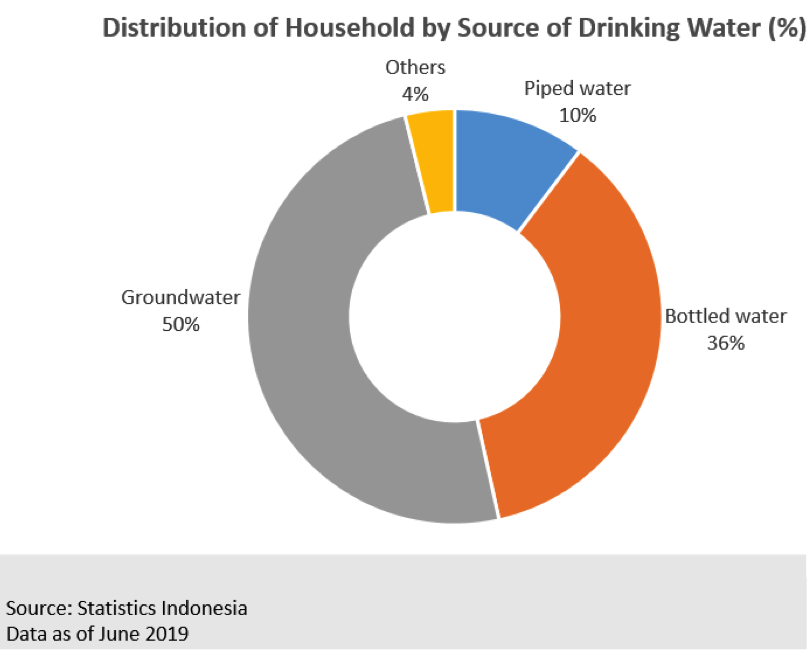
2.2 Solution
- Policy: Improve governance and eliminate water source pollution.
- WTPs: Implement centralized water resource management and establish large-scale Water Treatment Plants (WTPs) to meet rising demand.
- Tariffs: Implement competitive water tariffs to ensure sufficient cash flow for maintenance and new capital works.
2.3 Mission
- Entity: Forming strategic alliances with government agencies, foreign investors, leading international water supply groups, and local water supply operators.
- Supply: Establishing 14 new water treatment plants (WTPs) in major Borneo cities through a unified Public-Private Partnership (PPP) initiative.
3.0 Product
3.1 Product Description
The product is a single clean water supply treatment plant management entity. It provides coagulation, flocculation, sedimentation, filtration, and disinfection services. The operator will be responsible for the supply, operation, and financial management of the 14 new drinking water treatment plants in Borneo.
Drinking water treatment process
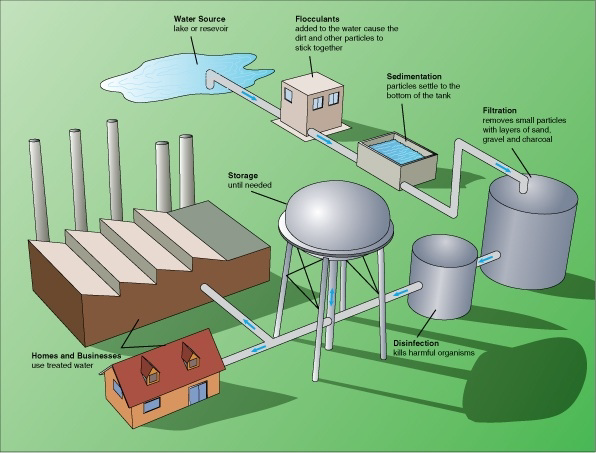
3.2 Product Attributes
- User: Designed to serve a population projection of 30 million.
- Capacity: Capable of providing clean water to 375,000 liters per second, accommodating the projected population.
- PPP Collaboration: Involves an international water treatment specialist/operator, financial service providers (equity investors, bridging financiers, and debt insurance entities), government procurement agencies, and local water treatment plant developers.
- Attributes: Key attributes of the water treatment process include reducing impurities, eliminating odour, colour, and hardness, ensuring safety for drinking, and eliminating corrosive ingredients.
3.3 Product Benefits
- Health: Provides clean water for a healthier life.
- Green: Reduces plastic waste from bottled water.
- Protection: Eliminates harmful microorganisms through water purification.
- Efficiency: Soft water maintains appliance efficiency.
- WTP Projects: The establishment of 14 new Water Treatment Plant (WTP) projects will provide piped water to target customers and assist the government in achieving its water supply objectives.
- Infrastructure Benefits: Introduction of new WTPs, pipelines, and improved management will lead to reduced water leakage, lower groundwater exploitation, and mitigated land subsidence, preserving valuable resources and infrastructure.
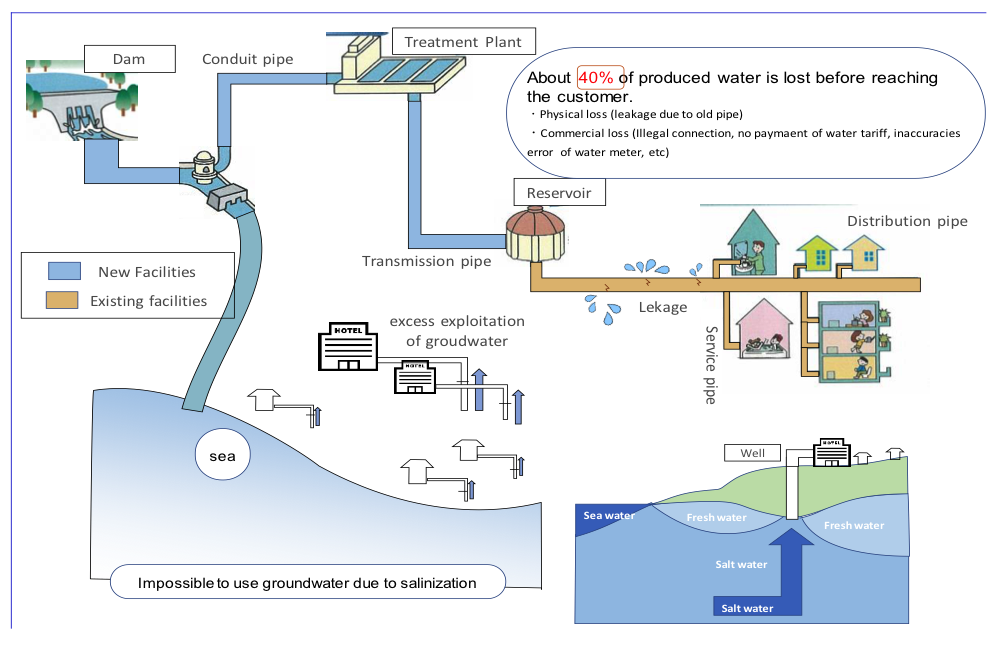
3.4 Product Competitive Advantages
- Team: The international consortium includes top global water supply system operators, financial experts, and management specialists.
- Market: The target market demand aligns with government projections, ensuring consistent demand.
- PPP Model: The public-private partnership model benefits investors, operators, the public sector, and the community by setting clear criteria and financial returns.
- Natural Reservoirs: Borneo Island’s abundant forests, rivers, and regular rainfall contribute to natural reservoirs, enhancing water supply sustainability.
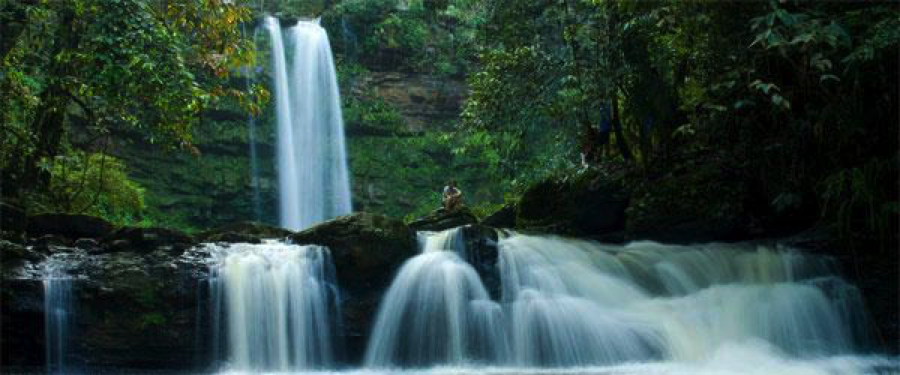
4.0 Market
4.1 Market Segment
The target market encompasses the following regions and cities in Borneo:
- Kalimantan: New Capital, Samarinda, Banjarmasin, Balikpapan, Pontianak, Palangkaraya, Tarakan, and Tanjung Selor.
- Sabah: Kota Kinabalu, Tawau, and Sandakan.
- Sarawak: Kuching and Miri.
- Brunei: Bandar Seri Begawan.
Borneo Island: 14 new Water Treatment Plants (WTP) in the major cities
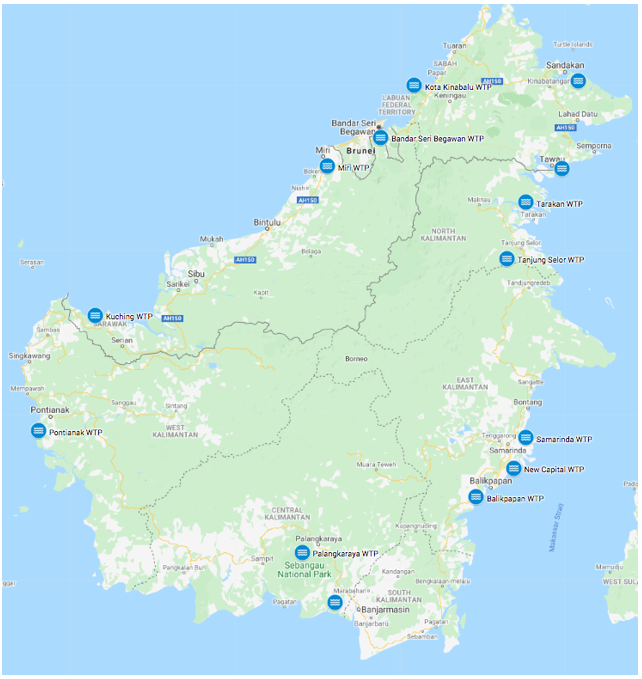
4.2 Target Market Segment Strategy
The strategy is based on:
- Demand-Driven Approach: Identifying population growth centres and addressing their need for clean water. This includes new capital cities, major Borneo cities, emerging SEZ hubs, and tourist destinations.
- Financial Focus: Concentrating on urban hubs to ensure financial viability.
- Bankability through Partnerships: Collaborating with government agencies, international investors, and local partners to ensure project feasibility and sustainability through PPPs.
4.3 Market Needs
- Indonesia: The government’s goal of achieving 100% access to safe drinking water and sanitation facilities necessitates a substantial US$42 billion investment by 2019.
- Sabah: In 2021, clean water coverage stood at 79%, with rural accessibility at 54%. There is a significant gap between water demand and supply, requiring an investment of US$3.1 billion to replace and upgrade water supply systems.
- Sarawak: In 2019, water supply coverage reached approximately 81%, but there is a need for US$722 million for rural areas and a minimum of US$1.5 billion to upgrade existing systems.
- Brunei: Despite nearly 100% population access to clean water, upgrades to water treatment plants are essential. The government’s long-term strategy includes alternate funding, a new water tariff system, increased water supply, and the establishment of an efficient, high-quality water supply system.
4.4 Growth Drivers
- Population Growth: The 14 major cities are projected to have a population of 30 million by 2050.
- Urbanization: Migration of rural labor to cities increases urban water demand.
- Industrial Demand: New manufacturing activities lead to increased water usage.
- Regulatory Upgrades: Stringent regulations drive the need for equipment upgrades, enhancing service effectiveness, productivity, and cost reduction.
- Limited Water Sources: Limited access to clean water from rivers and wells underscores the need for reliable water supply solutions.
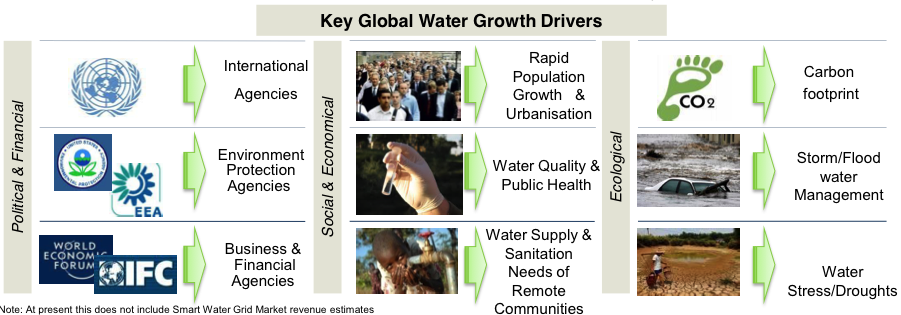
4.5 Key Customers:
- Kementerian Pembangunan (Ministry of Development), Brunei
- Kementerian Pekerjaan Umum dan Perumahan Rakyat (Ministry of Public Works and Housing), Indonesia
- Kementerian Kesehatan (Ministry of Health), Indonesia
- Perusahaan Daerah Air Minum (Regional Water Company), Indonesia
- Ministry of Public Works and Housing (MPWH), Indonesia
- Ministry of Home Affairs (MoHA), Indonesia
- Ministry of Finance (MOF), Indonesia
- Badan Perencanaan Pembangunan Nasional (BAPPENAS), Indonesia
- Jabatan Air Negeri Sabah (Sabah State Water Department)
- Kementerian Utiliti Sarawak (Ministry of Utilities), Sarawak
4.6 Competition and Industry
Top global players in the water industries
- Acciona
- American States Water
- American Water Works
- Ancala Water Services
- AquaVenturHoldings
- Aveng
- Badger Meter
- Beijing Enterprises Water Group
- Bouygues
- California Water Service Group
- China Everbright Water
- China Water Affairs Group
- Connecticut Water Services
- Core & Main
- Culligan
- Darco Water Technologies
- Ecolab
- Essential Utilities
- Evoqua Water Technologies
- Grundfos
- Huber Company
- Itron
- KSB
- Kubota
- Kurita Water Industries
- McConnell Dowell
- Middlesex Water
- Miya
- Moya Holdings Asia
- Pennon Group
- Pentair
- Primo Water
- Severn Trent
- Sanli Environment
- Saur
- SIIC Environment Holdings
- SJW Group
- Sound Global
- Suez Environment
- SWA Water Holdings
- The Athens Water Supply & Sewerage
- Thessalonika Water Supply and Sewerage
- Trident Water System
- United Utilities
- Utico
- Veolia
- Vince
- Watts Water Technologies
- Xylem
- York Water.
Local key players
- Acuatico Air
- Adaro Water
- Adhya Tirta Batam
- Amrita Enviro Energi
- Aquatec Maxcon
- Elmech Engineering
- Enviro Nusantara
- Envitech LAKU Management
- Jetama
- Lahad Datu Water Supply
- Perkasa
- Memiontec Indonesia
- Nusantara Infrastructure
- PAM Lyonnaise Jaya
- PP (Persero) Tbk
- PP Tirta Madani
- Ranhill Holdings (Malaysia)
- Salcon
- Swing (Indonesia)
- Tanah Alam Makmur (TAM)
- Timatch Water
- Tirta Bangun Nusantara (TBN)
- TKCM
5.0 Operation
5.1 Treatment Process
- Collection
- Screening and Straining
- Chemical Addition
- Coagulation and Flocculation
- Sedimentation and Clarification
- Filtration
- Disinfection
- Storage
- Distribution

5.2 Water Infrastructure Life Cycles
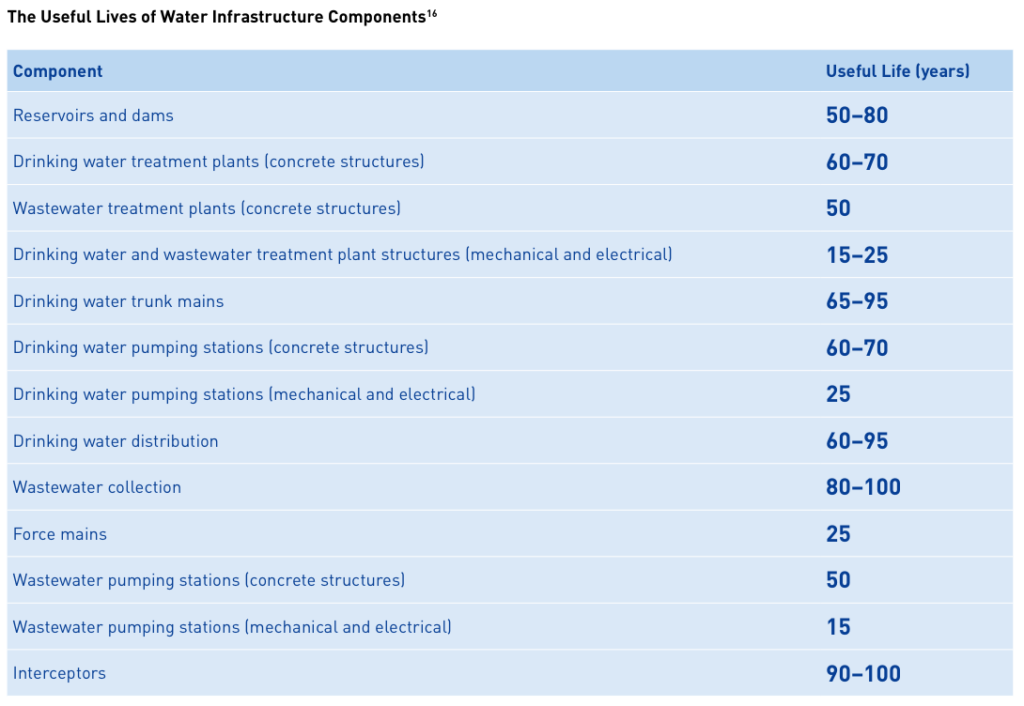
5.2 PPP Water Supply System In Indonesia
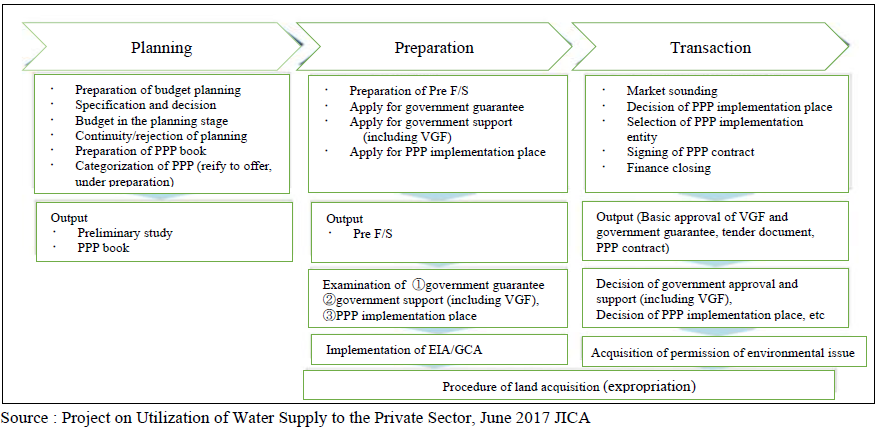
5.3 Legal System Of PPP Scheme – Water Supply Indonesia
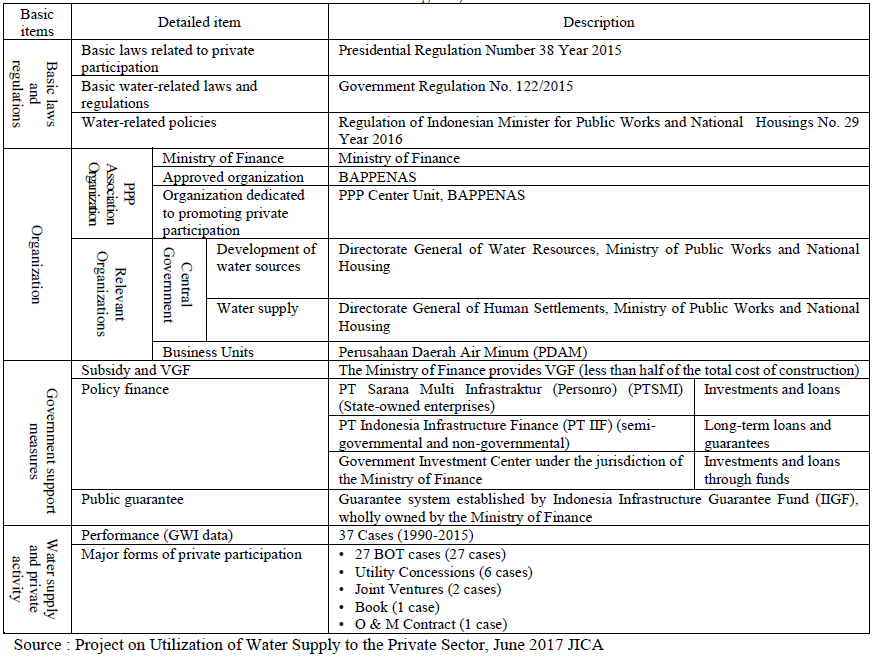
6.0 Financial Implications
6.1 Investment Segment
Water supply 30 million population X US$660/household = US$19.8 billion Case studies showed investment cost ranges from US$305 – US$1,125/capita for new services of the drinking water treatment plant and the upgrade of pipes. The investment segment will focus on the finance, plan, build, operation, maintenance and billing model for a concession period of 35 years.
Case Studies:
- Sarbagikung Regional Water Supply System
- Capacity: 2,300 lps
- Estimated Project Cost: US$222 million
- FIRR: 11.63%
- NPV: US$30 million
- Concession Period: 25 years
- Year: 2021
- Kamijoro Regional Water Supply System
- Capacity: 475 lps
- Estimated Project Cost: US$23.7 million
- FIRR: 15%
- Concession Period: 25 years
- Year: 2021
- Jatigede Regional Water Supply System
- Capacity: 2,000 lps
- Estimated Project Cost: US$142 million
- FIRR: 14.19%
- NPV: US$4.5 million
- Concession Period: 30 years
- Year: 2021
- Pantura Regional Water Supply System
- Capacity: 1,749 lps
- Estimated Project Cost: US$108 million
- FIRR: 11.97%
- NPV: US$15.8 million
- Concession Period: 25 years
- Year: 2020, 2021
- Dadimuria Regional Water Supply System
- Capacity: 500 lps, 40K customers
- Estimated Project Cost: US$45 million
- FIRR: 12.96%
- NPV: US$6.4 million
- Concession Period: 20 years
- Year: 2021
- Wosusokas Regional Water Supply System
- Capacity: 700 lps
- Estimated Project Cost: US$57.4 million
- Concession Period: 25 years
- Year: 2021
- Ir. H. Djuanda Water Supply
- Capacity: 6,673 lps
- Estimated Project Cost: US$1,007 million
- FIRR: 10.7 – 12.1%
- NPV: US$124 million
- Concession Period: 30 years
- Year: 2021
- Petanglong Regional Water Supply
- Capacity: 450 lps, 36K customers
- Estimated Project Cost: US$29 million
- IRR: 13%
- Concession Period: 30 years
- Year: 2021
- Jatiluhur I Regional Water Supply System
- Capacity: 5,000 lps
- Estimated Project Cost: US$137.5 million
- IRR: 13.62%
- NPV: US$27 million
- Concession Period: 30 years
- Year: 2021
- Bandar Lampung Water Supply System
- Capacity: 750 lps
- Estimated Project Cost: US$82.6 million
- IRR: 16%
- NPV: US$20.7 million
- Concession Period: 25 years
- Year: 2021
- Umbulan Water Supply System
- Capacity: 4,000 lps, 320K customers
- Estimated Project Cost: US$140.7 million
- IRR: 12.09%
- NPV: US$34.2 million
- Concession Period: 35 years
- Year: 2021
- Ntoum, Gabon DWTP
- Capacity: 140,000 m3/d for 1 million people
- Estimated Project Cost: US$58 million
- Year: 2013
6.2 Cost of Production
Projected water treatment plant operation cost = US$0.24/m3
30 million population / 4 persons per household X 165 m3/year =
1.237 billion m3/year
1.237 billion m3/year X US$0.24/m3 = US$297 million/year
Case Study
1: Indonesia – 375 PDAMs
Average Water tariff and Cost Coverage

Cost Structure of PDAM (2008)

2: Australia example showed average cost = US$300 / ML
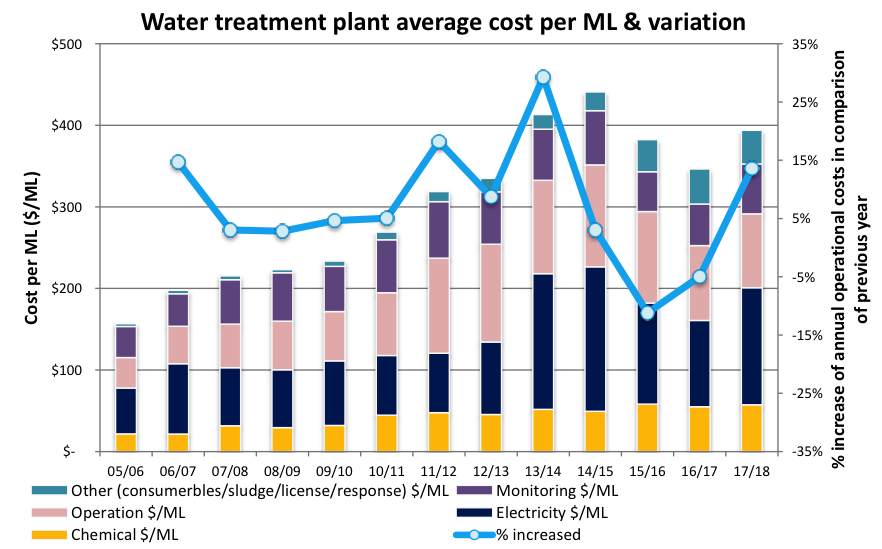
6.3 Price and Revenue
1. WTP revenue:
US$19.8 billion X 1.3 (Gross margin of 30%) = US$25.74 billion
Investment repayment - contribution per customer: US$25.74 billion/30 million customers = US$858/customer US$858/35 years = US$24.5/year US$24.5/12 months = US$2/month That is equivalent to the price of a bowl of noodles in Borneo.
2. Water tariff revenue:
Projected water treatment revenue: US$0.24/m3 X 1.25 = US$0.30/m3 1.237 billion m3/year X US$0.30 = US$371.1 million/year
Water tariff income will pay for operation, maintenance, upgrades, electricity, chemicals and management costs.
Case Studies:
Case study 1: Indonesia’s water supply tariffs and services

Case study 2: Bali Indonesia water bill rat

Study Case 3: Sarawak
Kuching Water Board Laku Management S/B

Source: KWB Sarawak

Source: Laku Management
Study case 4: Sabah
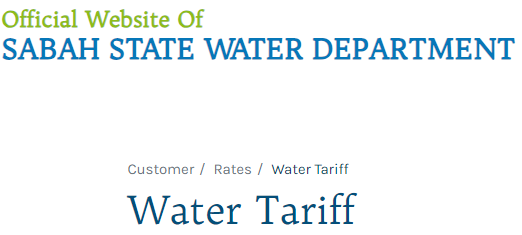
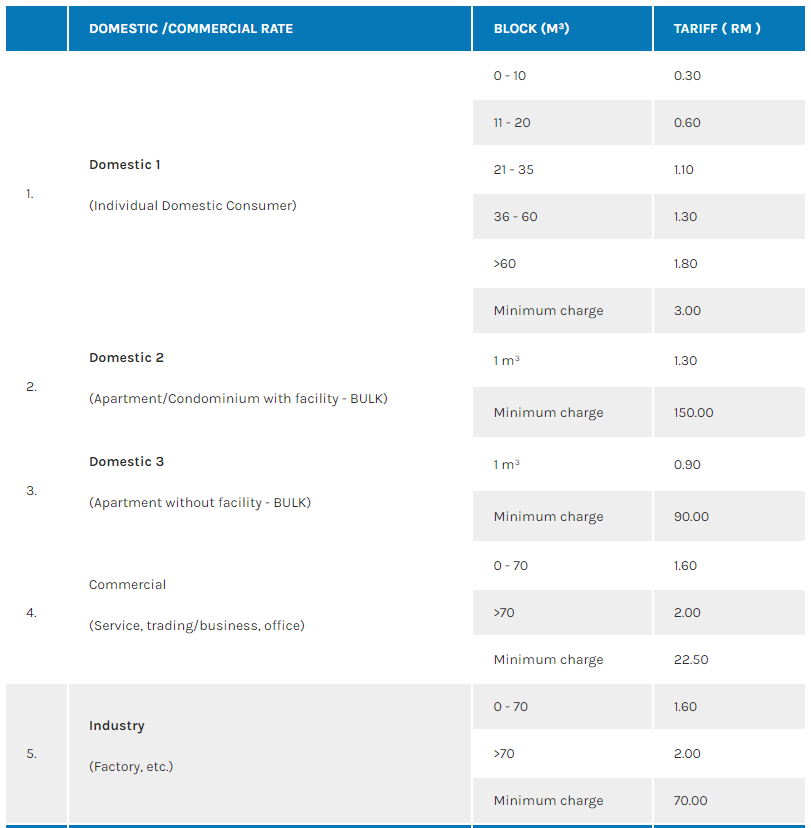
6.4 Financial Investment and Returns
Revenue – Cost = Income
1. Water treatment plants
• US$25.74 billion – US$19.8 billion = US$5.94 billion
2. Water tariff
• US$371.1 Million – US$297 million = US$74.1 million/year
• Concession = 35 years
Case 1: Indonesia’s water supply projects FIRR = 10.7%–16%
Case 2: Kabupaten Serang IRR = 18%–22%
Case 3: Thai Nguyen water supply Vietnam IRR = 13.56%
Case 4: Investment in water infrastructure Ireland = 9.8%
2019 Financial Income of listed water industry groups
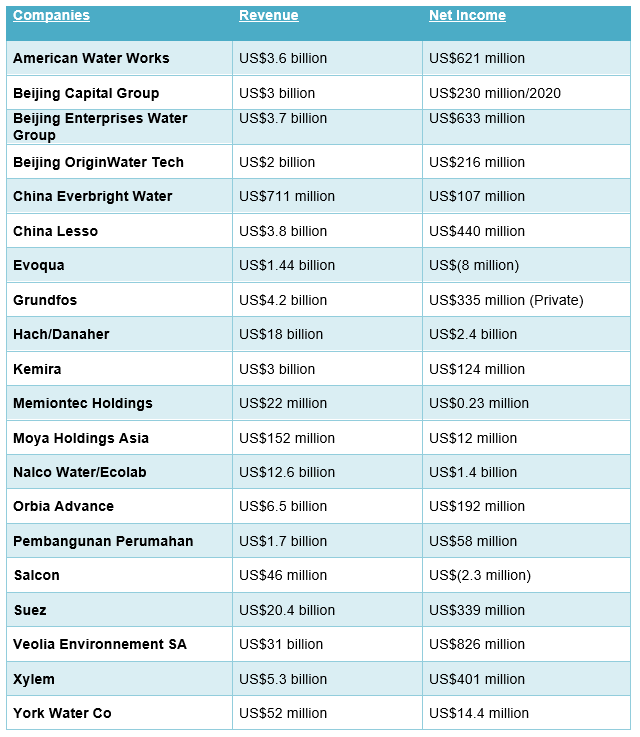
6.5 Source of Funding
1. Strategic Investors
- New Investor: Project leadership team with a business and financial focus.
- Financier: Water treatment private equity and investor groups.
- Water Treatment: International water treatment developer and operator groups.
- Government: Borneo Island – Brunei, Kalimantan, Sabah, and Sarawak Government water board and local water supply agencies.
2. Private Equities and Investors
- 3i Infrastructure
- Allianz Global Investors
- AMP Capital
- Amundi Asset Management
- Ancala Partners
- Antin Infrastructure Partners
- Apollo Global Management
- Arcus Infrastructure Partners
- Ardian Infrastructure
- Aristotle Capital Management
- AXA IM
- BC Investment Management
- BDT Capital Partners
- BlackRock
- BNP Paribas Asset Management
- Brookfield Asset Management
- Caisse des Dépôts et Consignations
- CAPFI DELEN Asset Management
- Carlyle Group
- Cascade Investment
- CDPQ (Caisse de dépôt et placement du Québec)
- CD&R (Clayton, Dubilier & Rice)
- Centerbridge Partners
- Champlain Investment Partners
- Cheung Kong Infrastructure
- China Asset Management
- China Investment Corp
- ClearBridge Investment
- Corfina Capital
- Cube Infrastructure Managers
- Davenport & Co
- DIF Capital Partners
- Dimensional Fund Advisors
- DWS Investment
- EQT Infrastructure
- Evercore
- Fairpointe Capital
- Fidelity International
- First Trust Advisors
- Fullgoal Fund Management
- Gates Capital Management
- Geode Capital Management
- Guokai Innovation Capital Investment
- Hermes Infrastructure
- HSBC Global Asset Management
- Huatai-PineBridge Fund Management
- IMPAX Asset Management
- Invesco
- JP Morgan Asset Management
- KBIGI
- KKR (Kohlberg Kravis Roberts & Co.)
- Krane Funds Advisors
- Kurita Water Industries
- Lyxor Asset Management
- M&G Investments
- Mackenzie Financial Corp
- Magellan Financial Group
- Matthews International Capital Management
- Metito Utilities
- MetLife Investment Management
- MNC Asset Management
- Morgan Stanley
- Mubadala Investment
- New Mountain Capital
- NiXEN Partners
- Nordea Investment Management
- Norges Bank Investment Management
- Northern Trust Investments
- Optinova InvAG
- Pai Partners
- Parnassus Investments
- Partners Group
- Pictet Asset Management
- Prescient Investment Management
- Principal Global Investors
- ProShare Advisors
- Prospera Asset Management
- RBC Global Asset Management
- Renaissance Technologies
- Robeco Institutional Asset Management
- Rothschild & Co
- RREEF America
- Salim Group
- Skagen Funds
- Solidium
- SSgA Funds Management (State Street Global Advisors)
- Sumitomo Corporation
- Tamaris Infrastructure
- Temasek Holdings
- TIAA-CREF Investment Management
- T. Rowe Price Associates
- Tweedy Browne
- UBS Asset Management
- Vanguard Group
- Vauban Infrastructure Partners
- Victory Capital Management
- WaterEquity
- Wellington Management
- Whitehelm Capital
- Yinhua Fund Management
3. Consultants, Development and Fund Managers to the Water Industries
- ADB (Asian Development Bank)
- Amane Advisors
- BCG (Boston Consulting Group)
- Bill & Melinda Gates Foundation Trust
- Deloitte
- Global Water Intelligence
- IDWA (Indonesia Water Association)
- IFC (International Finance Corporation)
- International Water Association (IWA)
- JICA (Japan International Cooperation Agency)
- KPMG
- NWB Bank
- OECD (Organisation for Economic Co-operation and Development)
- PWC (PricewaterhouseCoopers)
- Synergy Consulting
- The Roundtable on Financing Water
- World Bank
- World Water Council
6.6 The Big Picture
Water is our most invaluable resource, and privatising natural monopolies demands an ethical balance between profit and community needs, alongside transparent governance to combat corruption.
The industry trend involves merging global water supply stakeholders for competitive advantages through integration, cost-cutting, and quality improvement. The Suez and Veolia merger, with $42 billion in revenues, signals a transformative shift in the industry.
Bottled water companies, exemplified by China’s Nongfu Spring’s $85 billion valuation in 2021, show remarkable growth. Water supply treatment companies have ample opportunities to serve a growing market seeking sustainability.
7.0 Management Team
7.1 Key Management Team
- Mentors: Visionary pioneers and industry leaders with a vast global network, providing invaluable guidance and inspiration.
- Coaches: Mission-oriented industry experts offering practical solutions to keep the team focused on its objectives.
- Partners:
- Project Leadership Group: Experienced in development, operational management, and global marketing within the WTP industry.
- Reputable Investment Manager: With access to funding sources in the Asia Pacific WTP industry.
- Government Agencies: Offering business and financial incentives to support our initiatives.
- Local Water Supply Developer: A credible partner with procurement capabilities, a strong local network, solid financial standing, and government support.
In the water supply industry, several global leaders have made significant contributions, shaping its growth and success. Here is a list of some of these remarkable individuals, honoured for their vision and dedication:
- Antoine Frérot
- Christopher Gasson
- Mutaz Ghandour
- Gérard Payen
- Anthoni Salim
- Irma Setiono
- Gary White
- Dr Andreas Wibowo
These are just a few of the outstanding professionals and captains of the industry. The readers are encouraged to explore further and conduct their research to learn more about the management teams in this dynamic field.
7.2 Key Management Team Model
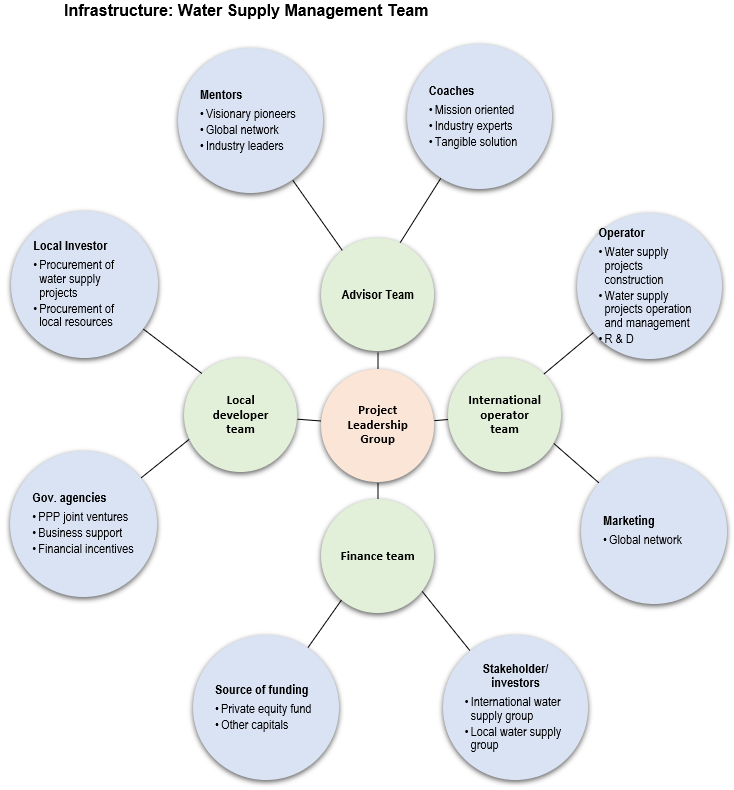
8.0 Unique Business Model
8.1 Successful Track Record
- The team consists of international water treatment plant specialists, financial service providers, local water treatment experts, and government agencies.
8.2 Entry Model
- Alliance: Establish strategic alliances with local water treatment plant operators, facilitating rapid market penetration and garnering support.
- Buy-out: Acquire existing water treatment companies, leveraging local expertise and generating immediate cash flow.
8.3 Unique Business Model
- Strength: Consolidate the unique strength of global exposure to water treatment projects.
- Finance: Foreign investors provide equity, bridging, and end finance.
- Partner: Unite PPP stakeholders and investors in a single entity with common objectives.
- Demand: Secure a strong market demand for the services.
9.0 Key Success Factors & Risk Mitigation
9.1 Key Success Factors
- Policy: Clear regulations reduce private investor risk.
- Tariff: Flexible water tariffs attract capital investment.
- Team: Expertise, financial stability, government support, and community acceptance are crucial.
- Goals: Stakeholder involvement and effective communication enhance performance.
- ESG: Transparent governance policies combat corruption and promote social justice.
9.2 Risks
- Risks include inadequate water supply, capacity limitations, permit delays, unviable financial returns, and economic instability.
9.3 Risk Mitigation
- Survey water supply sources.
- Design for scalable capacity.
- Collaborate with government agencies.
- Seek government guarantees.
- Secure long-term funding from financial institutions for stable infrastructure growth.
10.0 Exit Strategy
10.1 Forms of Exit
- Exit options include IPO (Initial Public Offering), buy-out, M&A (Mergers and Acquisitions), and transfer.
10.2 Key Attractions for New Investors
- Portfolio: Water supply projects offer stable long-term returns.
- Demand: Water treatment plant infrastructure provides an essential service with limited competition.
- Barrier: High barriers to entry due to the significant investment costs.
- Cost: Cost consolidation through new acquisitions of water supply projects.
- Growth: Opportunities for growth in an emerging market.
- ESG: A commitment to responsible corporate ESG (Environmental, Social, and Governance) with purpose-driven investment.
